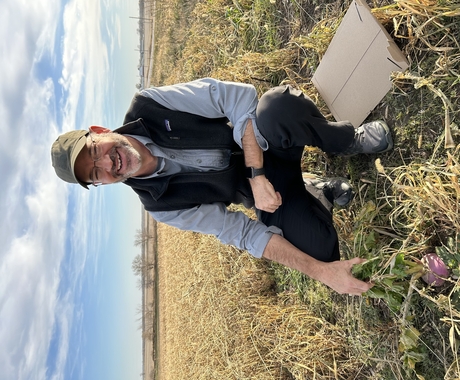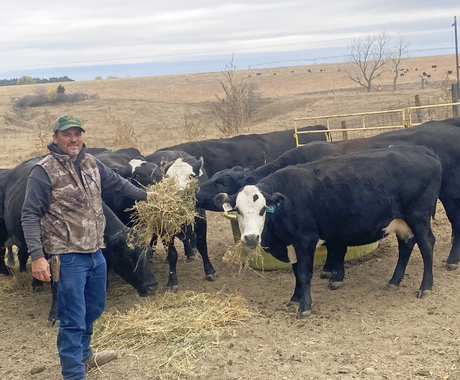Angelyn Wang contributed to this story.
For farmers just beginning to transition their operations to becoming U.S. Department of Agriculture (USDA) certified organic, creating an Organic System Plan (OSP) may seem daunting. The forms are long, and pose many questions. However, most people who start transitioning find that developing an OSP actually helps in making management decisions.
Margaret Scoles, executive director of the International Organic Inspectors Association, has been inspecting organic farms, livestock, and processing facilities for more than 30 years–and teaching inspectors almost as long.
She began doing inspections in Nebraska in 1990 and recently presented at the Center For Rural Affairs’s Organic Transition Academy on the six topics inspectors look at when certifying organic crops, as well as how to navigate online application forms for organic certification.
Introduction to the Organic System Plan
When applying for organic certification from USDA, farmers first need to create an OSP. The plan describes how their farming, handling, and/or processing practices meet organic standards. The OSP should explain a farmer’s operating plan, including information on crops, animals, harvests, sales, records, soil-building practices, pest management, health care, pasture, and any other practices related to organic production.
Farmers should not wait until they’re ready to be certified to start their OSPs. Plans should be developed and used throughout their transition, as well as when applying for organic certification.
“When the inspector does come, what we're doing is verifying that your OSP is complete and that it's accurate, and that you're not using any inputs that are not listed that the certifier didn't know about,” Margaret said. “We're verifying that your plan is in place.”
A useful tool for farmers is the National Organic Program Handbook, which provides guidance and instructions that can help when complying with USDA organic regulations.
“The handbook has all kinds of useful information in it that is not in the regulations,” Margaret said. “It has explanations of how the [USDA’s] National Organic Program views what the regulations say.”
Six standards considered when certifying organic crops
The USDA National Organic Standards Board (NOSB) considers and makes recommendations on a wide range of issues involving the production, handling, and processing of organic products. The NOSB advises the NOP and occasionally changes the standards.
Standards considered when certifying organic crops are land management, field history, boundaries, and buffer zones; seeds and planting stock; soil fertility, crop rotation, and manure management; pest, weed, and disease management; recordkeeping; and inspection and certification.
1. Land management, field history, boundaries, and buffer zones
There is a hard and fast rule with all organic production that farmers can have no prohibited substances on the field for three years before they harvest an organic crop. If prohibited substances are present at any time in those three years, the whole field is taken out of organic consideration. Farmers can plan their cropping system as they transition to take this into account.
“For example, if you have a vegetable operation and you're looking at the three years [certification period finishing during the upcoming growing season], something like lettuce, or something harvested early in the season, might not be certified,” Margaret said. “But if you planted winter squash it would be after that 36-month date before you could harvest it.”
Distinct, defined boundaries on buffer zones are required as well. Buffer zones are areas between the crops that are transitioning or certified organic, and conventionally grown ones. While many producers, both certified and not certified, assume there's a specified number of feet required in a boundary or buffer zone, that’s not the case.
“The buffer has to be adequate to prevent the unintended introduction of a prohibited substance, which in some ways makes it a little harder,” Margaret said.
A good set of farm maps is also an essential part of an OSP. The maps need to be precise enough that, along with the system plan, they show all field borders.
“If you're next to a conventional operation, you can typically prevent contamination with a border or a buffer,” Margaret said. “The more your map shows, and the more that your field history on your map jive, the more time you save on inspection. But, you will be asked to describe all of the boundaries on buffer zones for all of the fields.”
2. Seeds and planting stock
There are also requirements for the seeds used in certified organic systems. In most cases, farmers are expected to use organic seed when raising organic crops. However, allowances are allowed for using untreated non-organic seeds. If organic seed in the needed form, quantity, or quality is not commercially available, farmers may plant non-organic seed.
There is also an allowance for non-organic planting stock for perennials, as long as the farmer will not harvest for a year. People often plant apple trees, blueberry bushes, and asparagus from non-organic planting stock because they know they won't be harvesting anything for at least a year.
“Inspectors are really happy if we see that USDA seal on the sack of seed, but it is pretty common that we see non-organic seed,” Margaret said. “What you have to do is to try to get it from at least three known suppliers of organic seed, and if you can't get it from those three sources, then you keep records.”
Genetically modified organism (GMO) contamination is another consideration for farmers.
“If you're a non-organic producer, organic seed can be contaminated with GMOs,” said Margaret. “It's more likely to happen in non-organic seeds, so when you buy non-organic seed, just be aware that you may be buying seed that is allowed, because it's not treated, but it may be contaminated with a prohibited substance or with GMOs, and it's more likely to happen in non-organic seed.”
3. Soil fertility, crop rotation, and using manure in organic systems
Everything relating to organic certification goes back to soil health, specifically crop rotation and soil fertility.
A basic requirement is using cultivation practices that maintain or improve the physical, chemical, and biological condition of soil and minimize soil erosion. While there is no requirement for a soil test, they often provide valuable information.
“Some of these things become a little tricky for the inspector to verify and for the producer to confirm if there aren't any soil tests,” Margaret said.
Farmers also need to manage crop nutrients and soil fertility through rotations. Crop rotation involves not repeating the same crop or crop family from one year to the next on the same area without interruption.
“There are a lot of questions about crop rotation on the OSP form,” said Margaret. “And this is really key to an organic system, a soil-building crop rotation, because that's your primary source of fertility, unless perhaps, you have access to lots of manure, which is another way that people maintain an organic system.”
Farmers also need to be aware that manure and compost are considered distinct in organic systems. Materials are considered compost only if they are made via processes defined in the organic regulations, which are the same as the definition used by the Natural Resources Conservation Service (NRCS).
4. Pest, weed, disease management, and inputs
Inputs are items put into a farmer’s production process such as land, labor, seed, tractors and other machinery, fertilizer, pesticides, etc., and are one of many of the topics considered for certification. They are part of a farmer’s OSP and have to be approved by the certifier before use.
“We check to make sure that what you have in your system plan is actually what's being used, and why you're using it, and if it's being used according to your system plan,” Margaret said.
When certifiers find that farmers are using prohibited materials, the most common reason is that the farmer is not reading labels closely. Farmers may buy a product they have used before, but that product may have changed in name or content without the farmer realizing it.
As far as inputs, farmers must use management practices to prevent pests, weeds, and diseases, including, but not limited to, crop rotation and soil and crop management sanitation measures.
These practices may also include cultural practices like pruning out diseased vegetation or using strict good aeration in grain bins. For pests, farmers can use mechanical and physical methods such as traps or ladybugs. Other practices that can be a good fit for some operations include mulching with fully biodegradable materials, mowing, hand weeding, flame weeding, or others.
5. Recordkeeping
Recordkeeping requirements are much less intensive for organic certification than most people realize.
“People think it's a lot of paperwork and that the burden is onerous, but the rules about how good your records have to be are actually very simple,” Margaret said. “You do have to keep them for five years, and you have to have them available at the time of inspection.”
Margaret suggests keeping the labels for any inputs used, including the seed tags, and to write down what has been done. This can be as simple as recording things in a daily journal, or maintaining an online recordkeeping system, either through a free platform or a subscription-based software.
“I think the most important thing to remember is that there's no specific record that's required,” Margaret said. “Sometimes farmers just keep notes on their maps as they plant, and then they catch up on their records later. Keeping your records in real time is so valuable to you, and also makes it more likely not to have mistakes.”
6. Inspection and certification
Inspection occurs annually on every farm, and farmers are required to update their OSPs and pay fees once a year as well.
Margaret notes that, typically, the recertification process is much easier, although the reinspection process may not be any shorter.
“After you are certified, we spend a lot of time doing tracebacks, which is different from when you're first getting inspected and you don't have organic crops to audit,” she said. “We might take samples–5% of the operations that a certifier certifies has to be residue sampled–and unannounced inspections can occur as well.”
The inspector is usually the only person from the certification agency that will be at a farm and they will conclude their inspection with an exit interview. At that point, they tell farmers about any concerns. The exit interview has to be done with someone who knows the operation and is authorized to sign for it.
“We almost always present a written document, and we review it together with you, so there shouldn't be any surprises when you get your letter from the certification agency,” Margaret said. “What we're doing is verifying that the practices on the farm match the plan. So, it's important that if there is a reason for you to update your plan, you notify your certification agency, and don't wait for the inspector.”
Farmers may need to update their plans if they add another input, if there are equipment breakdowns, last-minute changes to seed purchases, and more.
“They're just part of farming, and you just have to remember that your OSP says you're doing something, and if you're doing something different, you need to notify the certifier,” Margaret said. “This is usually a very positive process. Actually, inspection is generally a really good opportunity to discuss your operation with someone else, and I, as an inspector, love all of those discussions.”
To view Margaret’s presentation, click here. For more information about organic certification, visit cfra.org/organic-transition.





